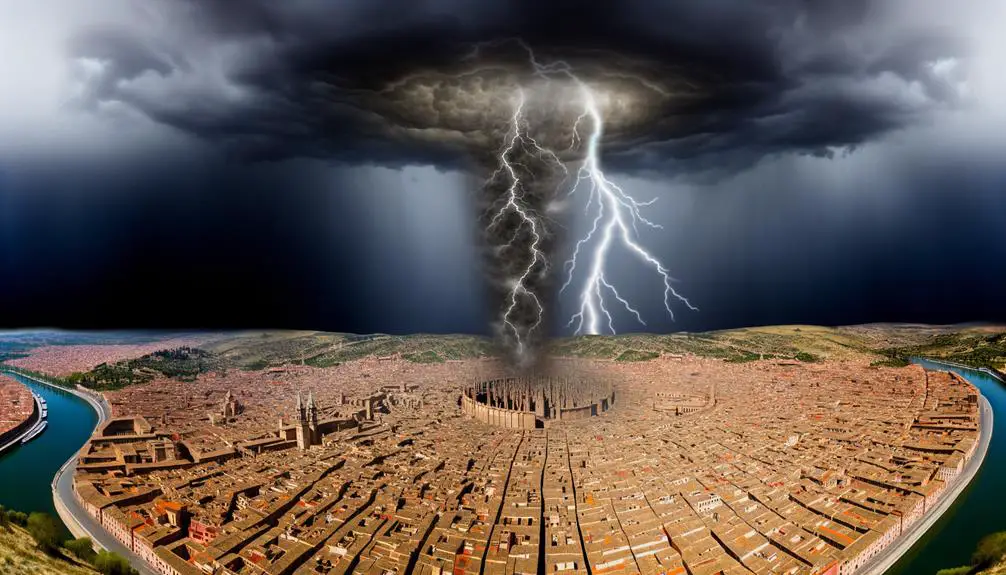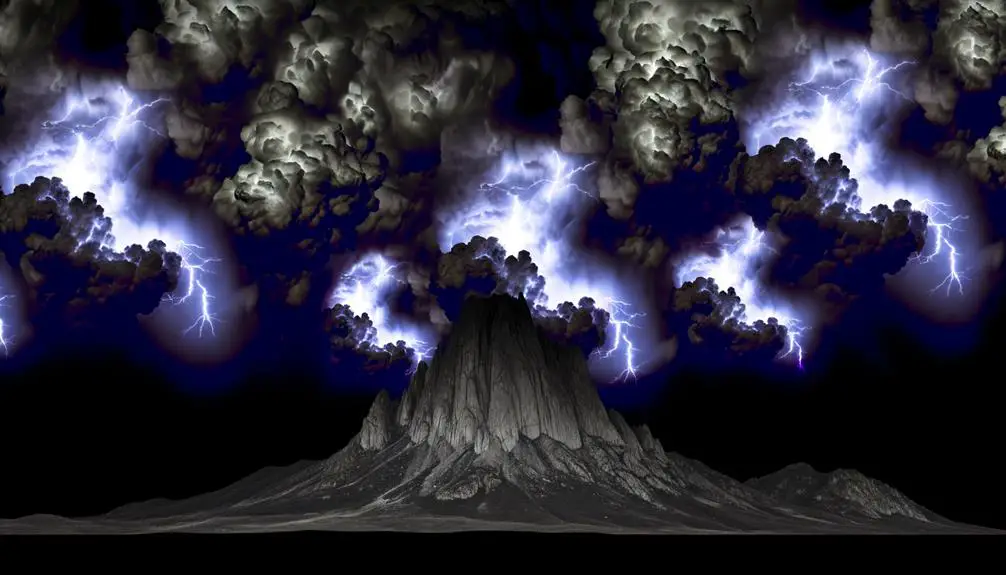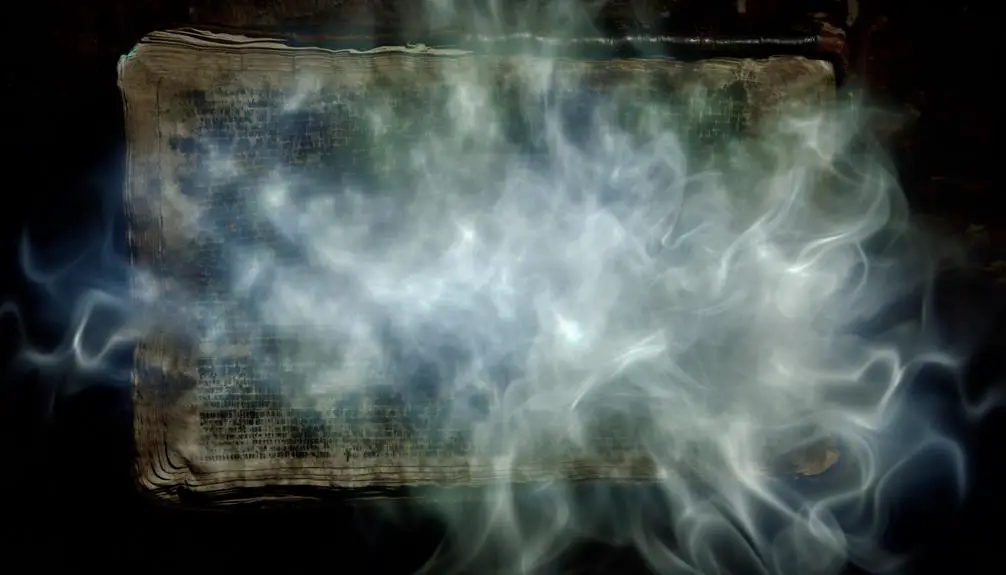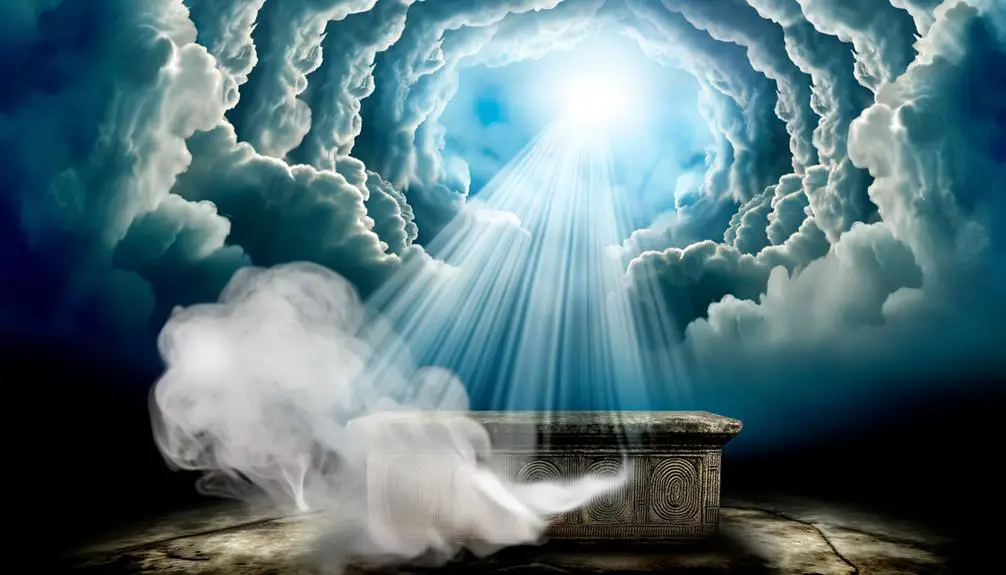Ponder the profound symbolism of smoke in the Bible, from divine presence to judgment, and discover its deeper spiritual significance.

What Does Smoke Represent in the Bible
You might think the Bible inadvertently became the original smoke signal manual, but in reality, smoke in its sacred pages signifies far more than a mere 'I'm over here.'
From representing God's overwhelming presence to signaling sacrifice, smoke weaves through biblical narratives, offering insights into divine mystery and majesty. It's a multifaceted symbol that touches on judgment, glory, and even wrath.
Yet, beneath these layers of smoke, there's an invitation to explore deeper meanings that could illuminate your understanding of these ancient texts. Uncover why this element is more than a dramatic backdrop; it's a pivotal piece of the spiritual puzzle.
Key Takeaways
- Smoke symbolizes God's presence, guiding and protecting humanity through divine interactions.
- It represents worship, atonement, and the purification process in sacrifices.
- Smoke signifies divine judgment, warning of retribution against sin and disobedience.
- Smoke embodies mystery and divine will, acting as a bridge between the finite and infinite.
Symbol of God's Presence

Throughout the Bible, smoke often serves as a tangible symbol of God's presence, manifesting His proximity and power to His people. This imagery, rich in cultural and historical context, invites you to delve into the layers of meaning behind such a potent symbol. Analyzing biblical narratives, you'll find that smoke not only signifies God's presence but also His guidance and the establishment of covenants, serving as a cloud guidance and a covenant signal, respectively.
The cloud guidance aspect is vividly illustrated during the Israelites' exodus from Egypt. Here, smoke, in the form of a pillar of cloud by day, becomes a physical manifestation of God's guidance and protection. This imagery conveys a clear message about the nature of divine leadership—it's constant, protective, and directly involved in the lives of the faithful. The smoke leads, shelters, and reassures, embodying God's unwavering commitment to guide His people through their trials and tribulations.
Similarly, smoke as a covenant signal is prominently featured during key moments of covenant-making between God and His people. For instance, when God establishes His covenant with Abraham, smoke, along with fire, passes between the pieces of sacrificed animals, symbolizing God's binding commitment. This scene not only underscores the solemnity of the covenant but also highlights smoke's role as a visible sign of God's presence and the seriousness of His promises.
In essence, smoke in the Bible acts as a multifaceted symbol that enriches your understanding of God's relationship with humanity. Its presence signals divine proximity, guidance, and the solemnity of divine promises, offering a deeper insight into the nature of God's interactions with His people.
Indicator of Sacrifice

In addition to serving as a symbol of God's presence and guidance, smoke in the Bible also functions as a critical indicator of sacrifice, denoting moments of worship and atonement. This imagery not only underscores the seriousness of the sacrificial act but also illustrates smoke's role as a communication medium between the divine and the mortal realm. When you delve into the scriptural accounts, it becomes evident that the rising smoke from burnt offerings and sacrifices symbolizes prayers and supplications ascending to God, suggesting an intimate, interwoven relationship between worship, communication, and divine acknowledgment.
Moreover, the act of burning sacrifices and the resultant smoke are deeply entwined with the purification process. This concept is pivotal, as it reflects the transformation of the physical into the spiritual, where the material substance—often an animal or grain offering—is consumed by fire, releasing smoke that rises to the heavens. This process signifies the purification of the worshippers and their earnest intentions, cleansing them of their sins and imperfections in the sight of the divine.
Analyzing these instances, it's clear that smoke functions not merely as a byproduct of fire but as a multifaceted symbol carrying layers of meaning within the biblical narrative. It acts as a tangible manifestation of the abstract concepts of atonement, purification, and divine-human communication. Through this lens, the biblical portrayal of smoke invites you to contemplate the profound depths of sacrifice and its significance in fostering a closer, purified relationship with the divine.
Manifestation of Glory

You'll find that smoke in biblical narratives often symbolizes the divine presence, serving as a tangible marker of the sacred.
This visibility of smoke signifies the majesty of the divine, bridging the ethereal with the material.
Analyzing these instances, you discern how smoke not only conveys God's glory but also communicates His proximity and power to believers.
Divine Presence Displayed
Numerous biblical passages depict smoke as a profound symbol of God's divine presence and the manifestation of His glory. This imagery serves not only as a visual cue but also as a deep, interpretive layer conveying sacred mystery and divine majesty. Cloud imagery, in particular, weaves throughout the narrative, symbolizing both the immanence and transcendence of God.
Reference |
Significance |
|---|---|
Exodus 19:18 |
Mount Sinai enveloped in smoke signifies God's presence. |
Revelation 15:8 |
The temple filled with smoke, illustrating God's glory and power. |
Isaiah 6:4 |
The temple filled with smoke, denoting a divine, holy presence. |
This table highlights instances where smoke directly correlates with God's divine presence, inviting readers into a deeper understanding of sacred mystery.
Majesty's Visible Sign
Building on the understanding of smoke as a symbol of God's presence, it's crucial to explore how this imagery further unfolds to reveal His glory's majestic manifestation.
The Bible intricately weaves cloud imagery and ethereal phenomena to symbolize not only the divine presence but also the overwhelming majesty of God.
This manifestation of glory through smoke and clouds serves as a visible sign to the people, a tangible expression of the untouchable and transcendent nature of God.
Analyzing these biblical instances, it becomes apparent that the use of smoke transcends mere presence; it embodies the awe-inspiring and formidable aspect of God's character.
Through this lens, smoke and clouds become not just symbols, but a medium through which God's majestic glory is both concealed and revealed.
Sign of Judgment

Throughout the Bible, smoke often serves as a potent symbol of divine judgment upon nations and individuals alike. This emblematic representation is deeply embedded in the narrative structure and theological themes of the scripture, highlighting the severity and inevitability of divine retribution. The imagery of smoke, especially when associated with fire, underscores not only the immediacy but also the cleansing aspect of God's judgment.
In exploring the significance of smoke as a sign of judgment, consider the following elements:
- Cleansing Fire: Smoke emanating from fire symbolizes purification processes. In biblical contexts, this often means the removal of sin or impurity from a person or a community. The concept of a cleansing fire is pivotal in understanding the transformative power of divine judgment, aiming not solely at punishment but at renewal and restoration.
- Prophetic Visions: Prophets in the Bible frequently describe their visions of divine judgment using smoke. These visions serve as warnings to the people, offering them a chance to repent before the judgment is executed. The smoke in these visions symbolizes the presence of God in the act of judgment, emphasizing its divine origin and inescapability.
- Historical and Eschatological Events: Smoke is used to mark significant moments of divine intervention in history, such as the destruction of cities or the downfall of empires. It also figures prominently in eschatological prophecies, symbolizing the final judgment and the purification of the world from sin.
In interpreting these elements, it becomes clear that smoke as a sign of judgment in the Bible communicates God's righteous indignation and the hope for redemption through purification.
Expression of Wrath

You'll find that smoke in biblical texts often embodies the intensity of God's anger, serving as a tangible marker of divine wrath. This imagery underscores a critical dimension of divine judgment, where smoke not only signals the presence of God's wrath but also amplifies its severity.
Through these narratives, the display of wrathful presence via smoke becomes a powerful symbol of both warning and consequence.
God's Anger Manifested
In the biblical narrative, God's anger is often depicted through dramatic natural phenomena, signifying His divine wrath in response to human transgression. This manifestation can take several forms, but three notable ones include:
- Fiery imagery: Often, fire and smoke signify God's presence and His immediate displeasure. This symbolism isn't just about destruction but also a cleansing act, purifying the sinful nature of humanity or specific individuals.
- Earthly disturbances: Earthquakes, storms, and other cataclysms serve as physical embodiments of God's anger, reminding humans of their vulnerability and the divine power over creation.
- Plagues and famines: These are direct responses to disobedience, designed to bring people back to God's path through hardship and suffering.
Each of these elements underscores the gravity of sin and the seriousness with which God approaches covenantal breaches.
Divine Judgment Symbol
Smoke, often enveloping scenes of divine wrath in the Bible, serves as a powerful symbol of God's judgment against sin and rebellion. This imagery isn't just about destruction; it's deeply tied to the purification process and covenant renewal. Through the billowing smoke, a narrative unfolds, one where purification paves the way for a renewed relationship with the divine.
Aspect |
Significance |
|---|---|
Purification |
Smoke as a metaphor for cleansing sin and impurity |
Judgment |
Divine retribution for disobedience and rebellion |
Covenant Renewal |
Post-judgment, a promise of renewal and hope |
Analyzing these elements, you'll grasp how biblical smoke transcends mere wrath, embodying both a cleansing fire and a beacon for renewal.
Wrathful Presence Displayed
Having explored smoke as a symbol of divine purification and covenant renewal, we now turn our attention to its role in manifesting God's wrathful presence. This aspect of smoke is vividly portrayed through:
- Angelic messengers who, amidst billowing clouds of smoke, deliver decrees of divine retribution, serving as harbingers of judgment.
- Prophetic visions where smoke symbolizes the imminence of God's anger, enveloping the wicked in a shroud of doom.
- Divine interventions where smoke not only signifies God's presence but also His readiness to enact punishment on those who defy His commandments.
This imagery reinforces the multifaceted nature of smoke in biblical narratives, serving not just as a marker of sanctity but also as a profound manifestation of divine wrath.
Veil of Mystery

Throughout biblical narratives, smoke often serves as a veil of mystery, obscuring divine actions and intentions from human understanding. This enigmatic symbolism invites you to delve deeper into the scriptures, seeking to uncover the hidden meanings and messages that lie beyond the immediate sensory experience. Smoke, in its ethereal form, represents the threshold between the known and the unknown, the seen and the unseen, challenging you to embrace the complexity of faith and revelation.
The biblical use of smoke as a metaphor for mystery doesn't merely add to the narrative's ambiance; it underscores the transcendence of the divine. It's a visual cue that what's unfolding or being communicated isn't fully graspable by human intellect alone. This imagery prompts you to acknowledge the limitations of your understanding and the necessity of faith in bridging the gap between God's ways and human perception.
Moreover, smoke's role in conveying enigmatic messages serves as a reminder of the divine's ultimate authority and inscrutability. It's a humbling motif, pushing you to reflect on the vastness of what you don't know and the infinite nature of divine wisdom. In this light, smoke becomes a symbol not just of mystery, but of the human journey towards enlightenment and understanding, marked by moments of confusion and clarity.
In essence, the biblical portrayal of smoke as a veil of mystery isn't just about the unknown. It's a profound invitation to explore, question, and ultimately, deepen your faith in the face of divine enigmas.
Harbinger of Salvation

While the veil of mystery often shrouds smoke's presence in biblical narratives, it also emerges as a profound harbinger of salvation, signaling divine intervention and the promise of deliverance. This symbolic manifestation isn't merely a backdrop but plays an integral role in conveying messages of hope and redemption. Through its ethereal form, smoke bridges the finite with the infinite, the human with the divine.
Smoke's role as a harbinger of salvation is evident in several key aspects:
- Cleansing Ritual: Smoke, arising from the burning of sacred incense, is central to rituals of purification. These ceremonies, deeply embedded in the fabric of biblical tradition, symbolize the removal of sin and the restoration of the individual's relationship with the divine. The ascending smoke represents prayers reaching heaven, an act that facilitates spiritual renewal and prepares the way for salvation.
- Prophetic Visions: Often, smoke is a precursor to prophetic visions that reveal divine will and foretell events of salvation. These visions, granted to prophets amidst smoke, serve as direct communication from God, offering guidance, warning, and hope to the people. They underscore the role of divine intervention in human affairs, promising deliverance from sin and adversity.
- Signal of Divine Presence: Smoke frequently signifies God's presence, an assurance of His involvement and commitment to salvation. It envelops sacred spaces, marking them as sites of divine action and interaction with humanity. This presence is both a comfort and a call, urging individuals towards faith and repentance.
Frequently Asked Questions
How Does the Interpretation of Smoke in the Bible Differ Across Various Christian Denominations?
Your exploration into how different Christian denominations interpret smoke reveals a rich tapestry of belief and practice. Denominational rituals play a significant role in shaping these interpretations, highlighting the interpretative diversity within Christianity.
This diversity isn't merely academic; it's woven into the fabric of worship and theology, offering unique insights into how symbols like smoke are understood in the context of faith, tradition, and scriptural exegesis.
Are There Any Instances Where Smoke Is Associated With Positive Events or Outcomes Not Directly Related to God's Presence or Actions?
Diving into the essence of your query, it's rare to find smoke symbolism tied to uplifting narratives without divine fingerprints.
However, in analyzing biblical texts, instances where smoke signifies purification, transformation, or a prelude to blessings, can be seen as indirectly positive.
These moments, though not explicitly joyful or devoid of divine intervention, hint at a broader spectrum of meanings, enriching the tapestry of interpretations within scholarly discussions.
How Has the Symbolism of Smoke in the Bible Influenced Christian Art and Literature Throughout History?
In exploring how smoke metaphors have shaped Christian art and literature, you'll uncover a rich tapestry of artistic interpretations. Smoke's symbolic essence, often tied to divine presence or judgment, permeates through centuries of creations, subtly influencing narratives and visuals.
This reflection on smoke not only showcases its profound impact but also invites you to appreciate the nuanced ways spiritual concepts are woven into cultural expressions, shaping the storytelling tradition within Christian history.
Can the Representation of Smoke in the Bible Be Linked to Specific Geographical Locations or Historical Contexts Within the Biblical Narrative?
Imagine you're exploring the ancient city of Jerusalem, witnessing the climatic influences on its cultural interpretations.
The representation of smoke in the Bible can indeed be linked to specific geographical locations or historical contexts within the biblical narrative. This connection enriches our understanding, providing a more nuanced view of its symbolism.
Analyzing these instances, you'll find that climatic and cultural factors shape the biblical portrayal of smoke, offering deeper insights into its significance.
How Do Modern Theologians and Biblical Scholars Reconcile the Ancient Symbolism of Smoke With Contemporary Understandings of God and Spirituality?
You're exploring how modern scholars bridge ancient symbolism, like smoke, with today's understandings of divinity and spirituality. They delve into environmental implications, considering smoke's impact on creation, and psychological effects, examining how smoke's imagery influences modern spiritual experiences.
This analytical approach blends historical interpretations with contemporary insights, offering a nuanced view of divine manifestations. It's about reconciling traditional symbols within a modern context, enriching our spiritual understanding.
Conclusion
In your journey through biblical narratives, you've uncovered smoke's multifaceted symbolism. It's not just a wisp in the air; it's a divine signpost. From marking God's tangible presence to heralding judgment and salvation, smoke weaves a complex tapestry of divine interaction.
But here's the intrigue: as smoke shrouds in mystery, it challenges you to look beyond the veil. What profound truths lie hidden in its ethereal embrace? This enigmatic symbol invites a deeper, more nuanced exploration of the divine narrative.



Sign up